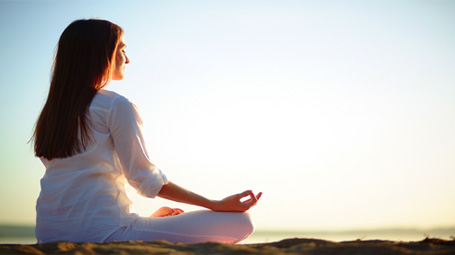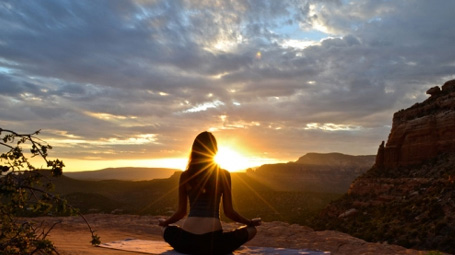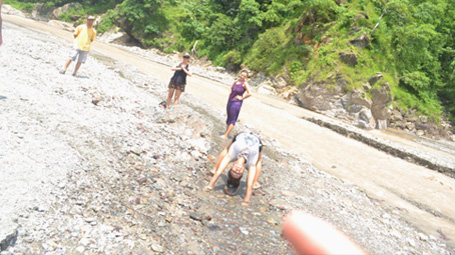Yoga & Meditation
Yoga defines itself as a science--that is, as a practical,
methodical, and systematic discipline or set of techniques that
have the lofty goal of helping human beings to become aware of
their deepest nature. The goal of seeking to experience this
deepest potential is not part of a religious process, but an
experiential science of self-study. yoga, with its powerful
techniques for creating a sense of inner peace, harmony, and
clarity of mind, is absolutely relevant to the modern
world--both East and West. Given the increasing pace and
conflict present in modern life, with all its resulting stress, one could say that yoga has become an essential tool for
survival, as well as for expanding the creativity and joy of our
lives.
Paths of Yoga as we indicated earlier, there is much confusion about exactly
what yoga is, especially since there seem to be so many
approaches, all described by the name "yoga." A mountain climber
may take a variety of routes to reach the top of a mountain.
From the plain at the base of the mountain, all these paths seem
distinct and different, but from the mountain summit, the view
is always the same! The same is true of the seeming diversity of
the yogic paths. These different paths are not mutually
exclusive or conflicting, but are intended to accommodate the
various inclinations, personalities, and temperaments of
individual students, and yet they all have the same goal.
These various paths of yoga include:
Hatha Yoga includes which deals mostly with body and breathing exercises that help
the student to become aware of his or her internal states. Hatha
yoga exercises help to make the body a healthy and strong
resource for the student.


Karma yoga means the yoga. This path teaches us to do our own duties in life skillfully and selflessly, dedicating the results of our actions to humanity. Practicing this aspect of yoga helps us to live unselfishly and successfully in the world without being burdened or distressed.
Jnana yoga is the path of knowledge and wisdom. This path involves intense mental discipline. Knowledge dawns as we learn to discriminate between the real and the unreal, between the transient and the everlasting, between the finite and the infinite. This path is meant for only a fortunate few, who are aware of the higher and subtler realities of life.
Bhakti yoga the yoga of devotion. This path is the way of love and devotion. It is the path of self-surrender, of devoting and dedicating all human resources to attaining the ultimate reality.
Kundalini
yoga is a highly technical science. The guidance of a competent
teacher is required to learn methods for awakening the
serpent-like vital force that remains dormant and asleep in
every human body.
Mantra yoga involves meditation and the use of certain sounds called
"mantras," which are traditionally transmitted to the student,
and are used as objects of concentration. Mantras help the
student in self-purification, concentration, and meditation.
These mantras were discovered in deep meditation by highly
advanced sages and teachers.
Finally, there is raja yoga, the "royal path" which is very scientific and thorough. By following this path methodically, we learn to refine our desires, emotions, and thoughts, as well as the subtle impressions and thoughts that lie dormant in the unconscious mind. Raja yoga helps us to experience the inner reality by using an eight-runged ladder. The ultimate goal is for the aspirant to attain the eighth rung, samadhi.
The Royal Path, Raja yoga encompasses teachings from all the different paths. Because of its variety it can be practiced by people of many backgrounds and temperaments. It involves all three dimensions of human interaction-- physical, mental, and spiritual. Through this path, we achieve balance and harmony of all three levels and then attain full realization of the Self.
Raja yoga is a scientific discipline that does not impose unquestioning faith, but encourages healthy examination. Certain practices are prescribed and the benefits derived from them are described so that this path can be scientifically verified by anyone who experiments with the methods. Because of this, raja yoga is ideally suited to the modern world, in which scientific skepticism is so prominent.
Raja yoga is also called astanga yoga, or "the eight-fold path," because its eight steps create an orderly process of self- transformation beginning on the level of the physical body, and eventually involving the subtler levels of life. The eight steps are yama, niyama, asana, pranayama, pratyahara, dharana, dhyana, and samadhi.


External Practices
the first four rungs or steps--yama, niyama, asana, and
pranayama, comprise the path of hatha yoga, which is preparatory
to the last four stages of raja yoga.
Yama and niyama are ten commitments of attitude and behavior.
One set of disciplines (niyama) is meant to improve the human
personality and the other (yama) is meant to guide our
relationships and interactions with other beings in the world.
Thus yoga is an education for both internal and external growth.
The five yamas, or restraints, are nonviolence, truthfulness, non-stealing, sensual moderation, and non- possessiveness. Their practice leads to changes in behavior and emotions, in which all negative emotions are replaced by positive ones. The five niyamas, or observances, are cleanliness (both external and internal), contentment, practices which bring about perfection of body and senses (tapas), study of the scriptures, and surrender to the ultimate reality. The niyamas lead to the control of our behavior and eventually are extremely positive factors in developing the personality.
In the beginning we should not be discouraged by the challenge of these first two steps. For example, even before we have succeeded in developing the trait of nonviolence completely, we will see increasing peace in our lives and meditation as a result of attempting to practice this yama.
Usually, when hatha yoga is taught in the modern world, only asanas (physical postures) and certain breathing practices are taught. Yama and niyama often are ignored. Because of this, hatha yoga has become somewhat superficial, sometimes emphasizing only physical beauty or egoism about skill and strength in postures. Certainly asanas and breathing exercises create physical health and harmony, but only when our minds are free from violent emotions can we achieve a calm, creative, and tranquil mental state.
Actually, there are two types of asanas--meditative postures and postures that ensure physical well-being. A stable meditative posture helps us create a serene breath and calm mind. A good meditative posture should be comfortable and stable, ensuring that the head, neck, and trunk are erect and in a straight line. If the body is uncomfortable, it makes the mind agitated and distracted. The second kind of postures are practiced to perfect the body, making it limber and free from disease. These postures stimulate specific muscles and nerves and have very beneficial effects.
The fourth step of raja yoga is pranayama. Prana is the vital energy that sustains body and mind. The grossest manifestation of prana is the breath, so pranayama is also called the "science of breath." These exercises lead to calming and concentration.


Internal Practices
the four steps of hatha yoga prepare the student for the four
internal practices of raja yoga. These internal practices are
pratyahara, dharana, dhyana, and samadhi.
The fifth step of raja yoga is pratyahara or withdrawal and control of the senses. While we are awake, the mind becomes involved with the events, experiences, and objects of the external world through the five senses of sight, hearing, touch, taste, and smell. The mind constantly gathers sensations from the external world through these senses and our mind reacts to them. To attain inner calmness, the student of yoga will want to develop the ability to voluntarily remove the distractions of the world outside. This is not a physical process but a voluntary, mental process of letting go of our involvement with external sensations
.Our sensory impressions distract the mind when we want it to become aware of serenity within. Thus, it is useful to learn dharana, or concentration, the sixth step in raja yoga. In concentration, the scattered power of the mind is coordinated and focused on an object of concentration through continued voluntary attention. This voluntary attention uses a conscious effort of the will, and it is developed through consistent practice. Through concentration, a scattered, weak mind is focused and made more powerful.
The seventh step in raja yoga is dhyana, or meditation. Meditation is the result of continued, unbroken concentration. Concentration makes the mind one-pointed, calm, and serene. Meditation then expands the one-pointed mind to the super conscious state. Meditation is the uninterrupted flow of the mind toward one object or concept. When the mind expands beyond conscious and subconscious levels and assumes this superconscious flow, then intuitive knowledge dawns. All the methods of yoga prepare us to eventually reach this stage of meditation and thus attain peace, perfection, and tranquility.
In our daily lives, meditation can be very helpful in eliminating many physical and psychological problems. A significant amount of the disease we experience is actually either directly or indirectly the result of conflicts, repression, or emotional distress arising in the conscious or unconscious mind. Meditation helps us to become aware of these conflicts and to resolve them, establishing tranquility and peace. In this way, meditation becomes a powerful resource for facing the challenges of daily life.
Yoga Courses for Beginners in Rishikesh, India
EWCR offers one and two weeks intensive yoga courses for beginners in India. The sole aim is the healing and well ness of the individual's body and soul through ancient techniques. EWCR stands out of the numerous Yoga Schools which have come-up in Rishikesh not only because of its simple methods and flexible schedules but also due to its location in peaceful forest area facing river valley with pin-drop silence and an environment which is safe and healing.
More over the Teachers at
EWCR will help you to
formulate a deep understanding of this ancient discipline that
has been practiced for centuries. Besides asana or postures, the
beginner will be taught meditation, chanting, pranayama, shat
karma or cleansing ritual. Any beginner who wishes to develop
their yoga practice further can continue their learning here.
The fee at EWCR US$ 220 for
the beginner level one week intensive program is most reasonable
as it includes accommodation and healthy yogic food. Apart from
Yoga, the participants are entitled for various activities at
discounted rates.
| EWCR - Yoga classes daily schedule | |
| 07:00 a.m. | Wake Up |
| 07:30 a.m. to 08:30 a.m. | Yogic Purification (Mon, Thur) |
| 07:30 a.m. to 08:30 a.m. | Pranayama (Tue, Wed, Fri, Sat) |
| 08:30 a.m. | Herbal Tea or Juices |
| 09:00 a.m. to 10:30 a.m. | Ashthanga Yoga Classes (Beginners and Intermediate) |
| 10:45 a.m. | Breakfast |
| 12:30 p.m. to 01:30 p.m. | Yoga Philosophy |
| 02:00 p.m. | Lunch |
| 04:30 p.m. to 06:00 p.m. | Hatha Yoga Classes (Beginners and Intermediate) |
| 06:30 p.m. to 07:30 p.m. | Meditation |
| 08:00 p.m. | Dinner with Group Discussion (Bonfire) |
| 09:30 p.m. | Lights Out |
Important Notes:
-
Duration of daily yoga classes can be increased, if required.
-
Daily schedule is subject to change depending on weather conditions.
Yoga Syllabus
-
Mantra chanting with Ethics of the day
-
Practice and Techniques of Shat karma (Cleansing techniques)
-
Practice and techniques of Asana (Physical postures)
-
Practice and techniques of Pranayama (Breathing practices)
-
Practice of Dhyan (Meditation)
Why Meditation
Eventually, we will be able to stay happy all the time, even in the most difficult circumstances.
The purpose of meditation is to make our mind calm and peaceful. If our mind is peaceful, we will be free from worries and mental discomfort, and so we will experience true happiness; but if our mind is not peaceful, we will find it very difficult to be happy, even if we are living in the very best conditions. If we train in meditation, our mind will gradually become more and more peaceful, and we will experience a purer and purer form of happiness. Eventually, we will be able to stay happy all the time, even in the most difficult circumstances.
Usually we find it difficult to control our mind. It seems as if our mind is like a balloon in the wind - blown here and there by external circumstances. If things go well, our mind is happy, but if they go badly, it immediately becomes unhappy. For example, if we get what we want, such as a new possession or a new partner, we become excited and cling to them tightly. However, since we cannot have everything we want, and since we will inevitably be separated from the friends and possessions we currently enjoy, this mental stickiness, or attachment, serves only to cause us pain. On the other hand, if we do not get what we want, or if we lose something that we like, we become despondent or irritated. For example, if we are forced to work with a colleague whom we dislike, we will probably become irritated and feel aggrieved, with the result that we will be unable to work with him or her efficiently and our time at work will become stressful and unrewarding.
By training in meditation, we create an inner space and clarity that enables us to control our mind
Such fluctuations of mood arise because we are too closely involved in the external situation. We are like a child making a sandcastle who is excited when it is first made, but who becomes upset when it is destroyed by the incoming tide. By training in meditation, we create an inner space and clarity that enables us to control our mind regardless of the external circumstances. Gradually we develop mental equilibrium, a balanced mind that is happy all the time, rather than an unbalanced mind that oscillates between the extremes of excitement and despondency.
If we train in meditation
systematically, eventually we will be able to eradicate from our
mind the delusions that are the causes of all our problems and
suffering. In this way, we will come to experience a permanent
inner peace, known as "liberation" or "nirvana". Then, day and
night in life after life, we will experience only peace and
happiness.